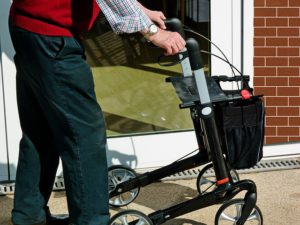Diagnosis
I have been diagnosed with multiple sclerosis since 2003. I have been struggling with this disease ever since Presidents Day 2003. My neurologist told me that I probably had the disease for 20 years prior to 2003 but it was undiagnosed. In 1985 I believe that I had optic neuritis, but most ophthalmologists told me I had a detached retina. The eye problem cleared up, and went on with my life until 2003, when I developed a limp. I continued my career until 2009 when I had to resign my position because walking became very difficult. I have learned a great deal about mobility issues and products and I would like to help others to choose appropriate mobility devices.
Wall walking
I began my struggle to walk with wall walking. I would hold onto walls, doors or anything I could find to maintain my balance. I used walkers, rollators and other devices to get around. I would hold onto the sides of cars to get through a parking lot. I would hold onto shopping carts for dear life.
Walkers
I would like to start with walkers. I tend to prefer walkers with two wheels in front. I have used both walkers with no wheels and walkers with two wheels. I have found that walkers with two wheels are easier to move and give me less fatigue. Walkers with no wheels are sturdy but are more difficult to move from place to place. If you find that you need the stability of the walkers without wheels, feel free to use them. The key is finding something that is comfortable for you.
Canes
I have used canes and they can be very useful. They provide the extra balance that I need to get around.
Wheelchairs
There are many types of wheelchairs, and depending on the circumstances, I have become familiar with all of them. Travel wheelchairs are light and convenient for the caregiver, but are a nightmare for the disabled person. It makes the disabled person totally dependent on the caregiver for mobility. However, it is lightweight and easier to get into a car. Manual wheelchairs give the disabled person more flexibility, and is an excellent source of upper arm exercise for the disabled person, but is a nightmare for the caregiver to get into a car. They often weigh too much and are too bulky for the caregiver to get into a car. Some power wheelchairs are designed for travel, but are often difficult for the caregiver to take apart and even more difficult to figure out how to put it back together. Power wheelchairs that are not designed for travel are often the only power wheelchairs that work in mobility vans, because they cannot come apart in the event of an accident. By the way, it is a good idea to keep the wheelchairs plugged in when not in use. I’ve had many technicians tell me that the power wheelchairs should be unplugged so as not to overcharge the battery. I have found that most power wheelchairs do not overcharge the battery and the battery lasts longer if it is plugged into the charger.
Lift chairs
The next subject I want to discuss is lift chairs. I have spent considerable time in a lift chair. It is important to get a comfortable lift chair. These chairs are motorized and electronically help lift the disabled person out of the chair. It is important to get a chair that is not too big. It should not be so wide that the disabled person cannot help push him or herself up and out of the chair. It also should not be so narrow that it is uncomfortable. The disabled person needs some room to move. Sitting in the same spot for an extended period can lead to ugly and painful sores. Also, the chair should not be so high off the ground that the disabled person’s feet are off the floor. None of these chairs move very fast and that is probably a good thing because you do not want the disabled person flying off the chair.
Hospital beds
As the disease progresses, I find myself spending more time in bed. There are a variety of hospital beds. You will need to find one that has comfortable and convenient side bars. The side bars are the only practical way for the disabled person to move up or down or side to side in the bed. The mattress and gel overlay also need to be comfortable. The gel tends to accumulate in one or two spots on top of the mattress making positioning and movement uncomfortable.
Patient lift
As time goes on, I rely increasingly on a patient type lift to transfer from place to place Whether it is a bed or chair, a patient lift is becoming more important. There are manual and motorized electronic lifts. The manual ones generally do not require any electric power, but the hydrolic part needs to be replaced periodically.
Conclusion
In conclusion, it is important to get a useful comfortable functional device that works well for the disabled person and caregiver.












